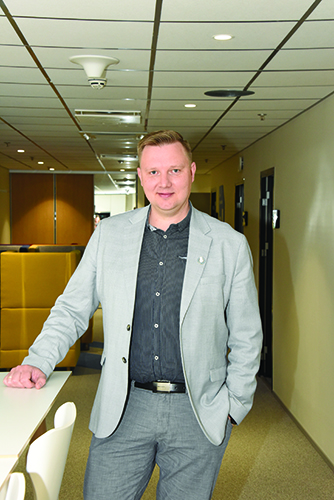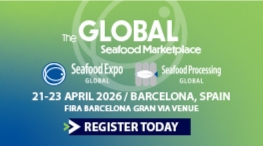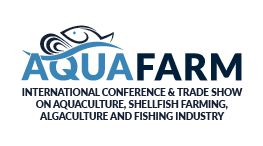Ylicool represents the new frontier of Baltic cuisine
This article was featured in Eurofish Magazine 4 2025.
A chef with his own catering company is -reimagining wild meats to include hitherto -largely unknown species like cormorants and seals. This development could create a new –market and help deal with the threat these -animals pose to fishers and fish farmers.
In the evolving world of gastronomy, where tradition often meets innovation, Urpo Reinthal stands out as a pioneer. The founder and head chef of Ylicool, a catering company based in Tartu, Estonia, Mr Reinthal is not only creating unique dishes but also pushing the boundaries of what is considered acceptable and sustainable food. While Ylicool offers a wide variety of catering options, it is Mr Reinthal’s work with two controversial and rarely used ingredients—seal and cormorant—that positions him at the vanguard of ethical and ecological culinary practices in Estonia.
The genesis of a culinary experiment
Ylicool started life as a restaurant nearly a decade ago before transitioning into a full-service catering operation. With Mr Reinthal as Ylicool’s owner, head chef, driver, waitress, and dishwasher, as he describes himself, the business has steadily built a reputation for sourcing and transforming unusual ingredients. In the 23 years he has been in the restaurant business, he has consistently advocated for sustainable gastronomy, an interest that has brought him into collaboration with local hunters, fishermen, and even the University of Tartu. The interest in using cormorant and seal meat is not born from culinary novelty alone. Mr Reinthal’s journey began when researchers from Tartu University brought him a cormorant and asked whether it was edible. “Every bird is edible,” he responded, and thus began his experimentation. Cormorants are widely considered a nuisance species in coastal Estonia, particularly by local fishermen as a single bird can consume up to 500 g of fish a day. Despite this ecological impact, hunting them involves complex regulations. After being shot, the birds must be inspected by a veterinarian, processed in a licensed facility, and only then can they be used in food preparation.
Undeterred by bureaucracy, Mr -Reinthal has become one of the few chefs in Estonia to study cormorant meat closely. What he discovered is a protein with unique properties—dark, lean, and highly sensitive to preparation methods. When pan-fried and served medium rare, it resembles liver or has a light fishy note. Smoked, it takes on the flavour of wild duck. When turned into beef jerky, it transforms again, this time tasting unmistakably like fish. In his words, “the cormorant is like a taste chameleon.”

Cooking courses for chefs is a good way to popularise ways to prepare the meat from cormorants and seals.
Its lean structure, with little to no fat or muscle, makes it tricky to prepare. The meat resists absorbing flavour unless marinated extensively. However, in the hands of a skilled chef, its adaptability becomes its greatest asset. Mr Reinthal has tested various methods: smoking, slow-cooking, frying, and tartare. He together with the Ministry of Regional Affairs and Agriculture has also hosted workshops where chefs from across Estonia tried their own interpretations of cormorant dishes. Herki Tuus from the ministry, who has been promoting consumption of cormorants, says it is a delicious bird. For tourists both local as well as those from abroad it is exotic to eat cormorant and many would like to try it. While public response is split—some diners find it fascinating and delicious, others reject it outright—Mr Reinthal believes that careful, creative preparation can win over sceptics. He notes that “if I tell you it’s fish, you believe it; if I say it’s meat, it works too. The taste changes so much depending on what I do.” Mr Tuus points out that although a bird weighs around 2 kg, it is really only the breast that is big and meaty enough to eat, it does not have drumsticks like other gamebirds. This relatively low yield combined with the fact that not many cormorants are shot, and that too only in the season from August to the end of the year, means that cormorant meat is priced at the high end which may put off potential buyers. Mr Reinthal, however, feels that tourists will not be deterred by the price as they would be attracted by the novelty of eating cormorant. For coastal areas this may be another way to supplement the incomes of fishers and hunters, increase the flow of tourists, and boost local economies. He is therefore also pushing to reduce the bureaucracy associated with hunting to increase the supply of cormorants to the market as well as to shorten the time between shooting a bird and having it delivered at a restaurant.
Seal meat goes from folklore to fine dining
Mr Reinthal’s foray into cooking seal came as a result of a workshop in Kihnu, a small Estonian island where seal hunting and preparation have been traditional practices for over a century. What began as a joke—“Next time I’ll cook seal!”—turned into a serious undertaking when locals handed him a 200-kilogram animal. Like cormorant, seal presents culinary challenges and ethical questions. The meat is dark, lean, and has a distinctive smell. The fat is stored in a layer under the skin. But again, Mr Reinthal’s approach is one of experimentation. He has tried boiling, smoking, preserving, and even making grilled sausages using a 50-50 mix of seal and chicken. He discovered that the fat, when melted, does not solidify in the same way as pork fat but remains flexible and oil-like, even when frozen. This oil, once filtered and flavoured with lime, salt, and balsamic vinegar, makes a surprisingly good salad dressing and has historically been used in cosmetics and medicine. Seal oil, high in omega-3 fatty acids, was once used to waterproof shoes and is now under consideration as a niche health product. Mr Reinthal envisions bottling it and selling it as a culinary and wellness item, potentially supporting local economies like Kihnu’s, which struggle with depopulation and limited resources.

The meat of these predators is highly versatile. Different preparations create very different tastes
and textures so even sceptical diners should find something that appeals to them.
Seal meat, he notes, is juicier than cormorant and has a softer texture. It does not dry out easily during cooking, thanks to the fat layer between skin and muscle. He has developed several preparations that appeal to a modern palate, such as sliced, marinated and smoked fat sliced on black bread with red onion and mustard mayonnaise—what he calls -Estonian tapas—that he recommends consuming with a shot of vodka!
Beyond taste: sustainability and bureaucracy
Both cormorant and seal are more than culinary curiosities. They represent a broader vision for local, sustainable food systems. Estonia’s coastal ecosystems suffer under the weight of overpopulated predator species. Traditional responses like egg oiling or trap deterrents have had limited success. Mr -Reinthal sees consumption as a pragmatic solution: “If you make it valuable, people will manage the population more responsibly.” However, hurdles remain. Current Estonian regulations classify cormorants and seals under strict licensing regimes, making it difficult for chefs to access the meat. While Kihnu residents enjoy certain exemptions due to cultural traditions, most other regions cannot legally sell or serve these meats, even if they are harvested under quota. Mr Reinthal, with support from the Estonian Head Chefs’ and Hunters’ Associations, is lobbying for reform. He wants to streamline the process so that freshly hunted animals can reach restaurant kitchens without weeks of administrative delay. He argues that there is a market for such products—especially among tourists seeking authentic, local experiences. If I’m a tourist and I go to a restaurant in Saaremaa and see cormorant or seal on the menu, I will try it. It’s something different. It may not be cheap, but it is unique.
The future of Baltic food
For Mr Reinthal, cooking is not just about flavour; it is about narrative, -ethics, and place. The use of wild ingredients connects food back to landscape, seasonality, and cultural memory. Whether it is a confit of wild duck or a smoked fillet of cormorant, his dishes tell stories—about resourcefulness, stewardship, and culinary courage. Ylicool’s future may very well lie in expanding these stories. The company already works with other wild meats like boar, deer, and beaver. But cormorant and seal offer a chance to shape the conversation around food in a way that takes levels of predation into account. As Mr Reinthal sees it, “we help the fishers, support local economies, and give tourists something unforgettable. It’s a virtuous circle.”
He does not anticipate these meats becoming everyday staples—you won’t buy cormorant in a shop, but their place in high-end and culturally rooted cuisine is, he hopes, just beginning. And in a world where novelty often trumps meaning, Mr Reinthal shows that food can be both radical and responsible. Through Ylicool, the Baltic table is being reimagined—not just with new ingredients, but with a new sense of purpose.









